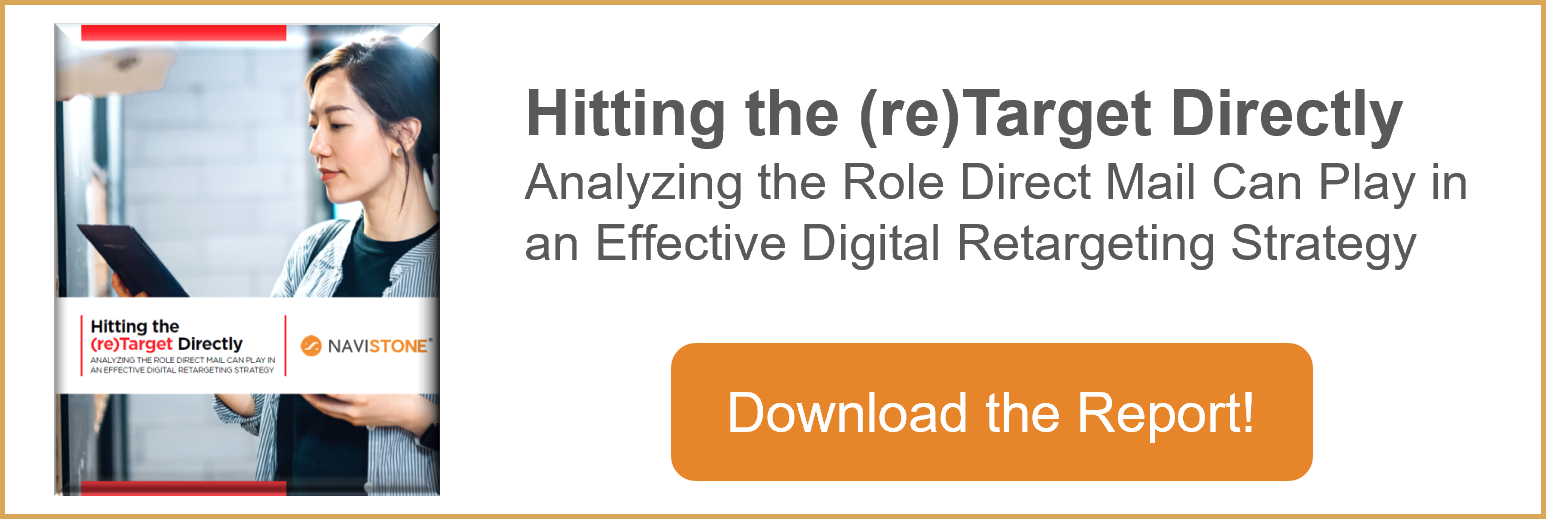
Direct mail is making a comeback in the digital age. Learn more about the benefits of direct mail, such as its ability to stand out among the noise of digital ads and the personal touch it can provide.
Direct Mail: It’s What’s Trending
As marketers experience major disruptions to digital programs including the loss of third-party cookies, ad blockers and Apple IOS changes, brands are looking for new ways to reconnect.
Reaching your consumers after they have already visited your website through remarketing helps your brand stay in front of abandoned site traffic. The fact is, typically less than 5% of website traffic converts. When you implement the practice of retargeting, you are staying top of mind by reminding your site visitors of your products and solutions. This can be done via display, email and direct mail. However, not all channels are as effective as the others. In this blog, we'll discuss some of the problems marketers are facing in retargeting today and how one channel is trending to the top in performance.
Problem #1: Digital Marketing Overload
The digital marketing space can be incredibly cluttered for consumers, with countless ads and promotions vying for their attention across various channels and platforms. The sheer volume of content can be overwhelming, making it difficult for consumers to sift through and find the information they are looking for. As a result, consumers may feel frustrated or even resentful towards brands that they perceive as being too pushy or intrusive in their digital marketing efforts.
Did you know on average the consumer receives…
- 1000+ Digital Ads per day
- 100+ Emails per day
- >8 Pieces of Mail per day
The uncluttered postal mailbox offers a more effective way to use powerful digital intent signals.
Problem #2: The Deprecation of Third-Party Cookies
Retargeting is one of the most used strategies in marketing. The ability to remind your customers of your products after they leave your website can be a powerful tool. With third-party cookies fading into the background, how is our ability to create audiences impacted?
The answer? The tried and true, first party data. First party data is data passively collected from customers through a brand’s own properties, such as a website or app.
The benefit to first-party data is that customers implicitly provide consent to this type of first- party data collection as they visit and engage with your website. (Source: mparticle)
In terms of potential changes to the deliverability of advertising, marketers should expect a shift back to first-party channels where the user is known (i.e., direct mail).
There is a perception that direct mail is “old school” and expensive, but the response rates still outperform an untargeted display ad in most cases. In fact, email averages a 0.12% response rate and display ads average a 0.3% response rate, while direct mail averages a 4.4% response rate. Brands are going to shift to channels that deliver high response rates, and direct mail is one of the best channels for this.
Problem #3: Multi-Channel Consumers
Consumers are everywhere, and your brand should be too. Today’s consumer is a multi-channel consumer. Outreach through digital channels only, such as social, display and email aren’t enough. You must get in front of the consumer when they are ready to transact, no matter where they are. And there is no better indication that someone is ready to transact than when they are browsing your website.
Stay in touch all along the path to purchase with tangible and relevant marketing sent directly to the home powered by online intent signals.
Direct Mail Solves These Problems
And then there are the dollars and cents of direct mail….
As marketers, we are already investing a lot of money to drive consumers to our websites, and conversions remain low. These high investments have caused demand to skyrocket. And with this demand, social media ad prices have skyrocketed. On top of that, iOS 14 affected the internal measurability of these ads by 30-50%.
In addition to all these recent changes in the digital space, companies are planning for a recession, vastly impacting marketing spend. You must spend your precious marketing dollars in the places that drive the greatest response and ultimately the lowest cost to acquire a new customer. Where you allocate your budget and see positive ROAS could be a “make it or break it” deal.
That is where Digitally Powered Mail comes in.
In the U.S., direct mail advertising is expected to increase from $42.79 billion in 2021 to $46.33 billion in 2026, representing a compound annual growth rate (CAGR) of 1.6%. The market is then projected to reach $47.93 billion in 2031, with a CAGR of 0.7% from 2026 to 2031.
Why? Because it is among the most effective channel.
According to Newswire, direct mail response rates are 2.7% - 4.4% compared to 0.62% for a combination of mobile, email, social media, paid search, and display.
Overall, direct mail advertising will continue to be a significant part of the marketing strategy for growth and retention. It is important for companies to evaluate their marketing strategies regularly and determine which channels are most effective for reaching their target audience in a personalized, measurable, and respectful manner.
In a study conducted by Total Retail in partnership with NaviStone, 90% of brands confirmed that direct mail conversion rates are greater than every other channel. In this same study, ~90% of brands confirmed that direct mail ROI is greater than every other channel- with 91% confirming greater than digital.
Worth noting is that online-to-offline automated “trigger” mail is rising steadily. Winterberry Group states the demand for digital-to-DM solutions is increasing as digitally native DTC brands see to retarget customers with physical mail pieces.
Additionally, US spend on programmatic direct mail campaigns driven by web-based triggers or behaviors is estimated at $317MM in 2022 and is forecast to grow +27.4% CAGR through 2026. This robust growth forecasts reflect a shift toward direct mail campaigns that connect the online buying journeys with offline messaging. (Winterberry Group)
And if this isn’t enough information to prove that Digitally Powered Mail is on the rise, then it’s worth noting that 94% of retail marketers use direct mail as part of their marketing strategy and 96% use personalization as part of direct mail strategy. (Total Retail Research Report)
Direct Mail has higher deliverability and a longer life than other advertising mediums. 47% of the population sets direct mail aside to read later, keeping direct mail in the home an average of 20.3 days.
Digitally Powered Direct Mail provides you…
- An audience that is known to be in market.
- An ad seen at home versus on a third-party website, which means longer life of your message.
- No ad-blockers or spam folders to contend with.
- Stable cost – no bidding against competitors.
- Best performance across all channels.


Lookalike Audiences Enhance customer acquisition by identifying high-potential prospects, boosting response rates, and lowering advertising costs.
Retargeting Postcards Double the performance of your direct mail retargeting.
Amplify Recognize unknown visitors who are actually customers. Add 20-40% to your ESP/CRM campaigns.
IQ Mail Retain customers with personalized, timely messages for those opting out of digital channels.






Comments